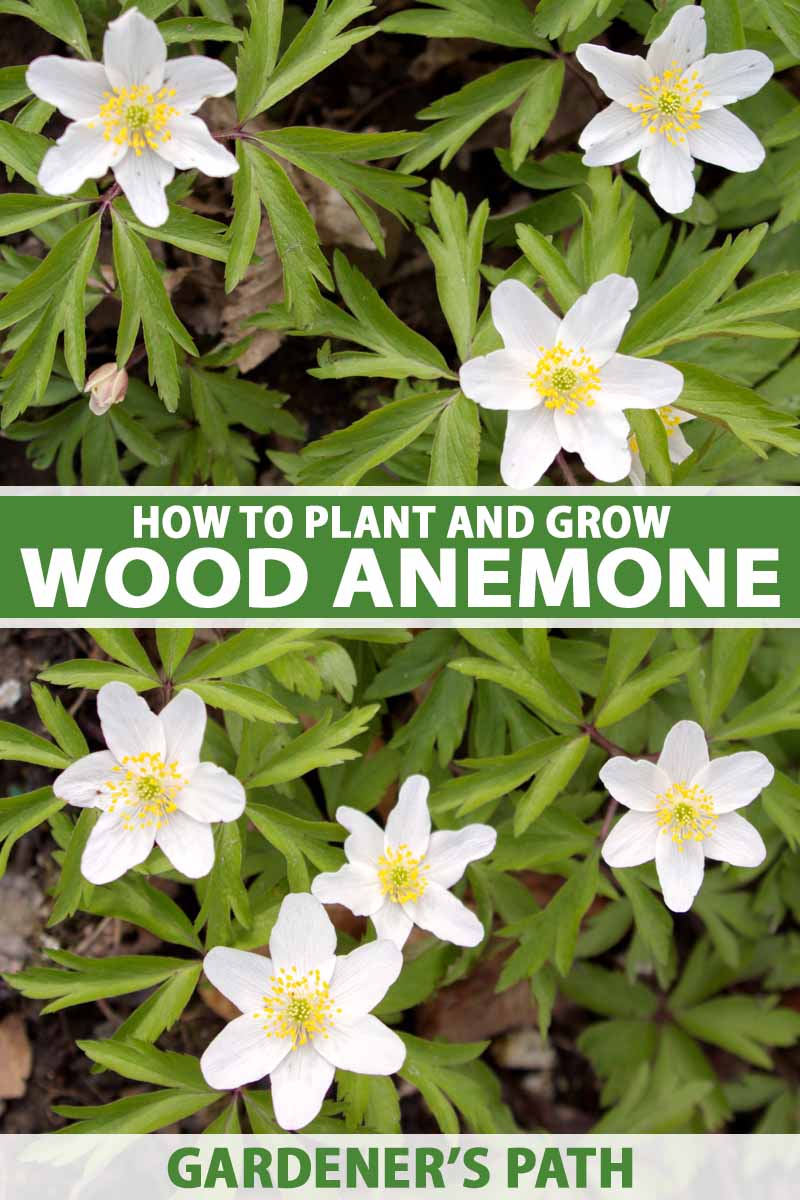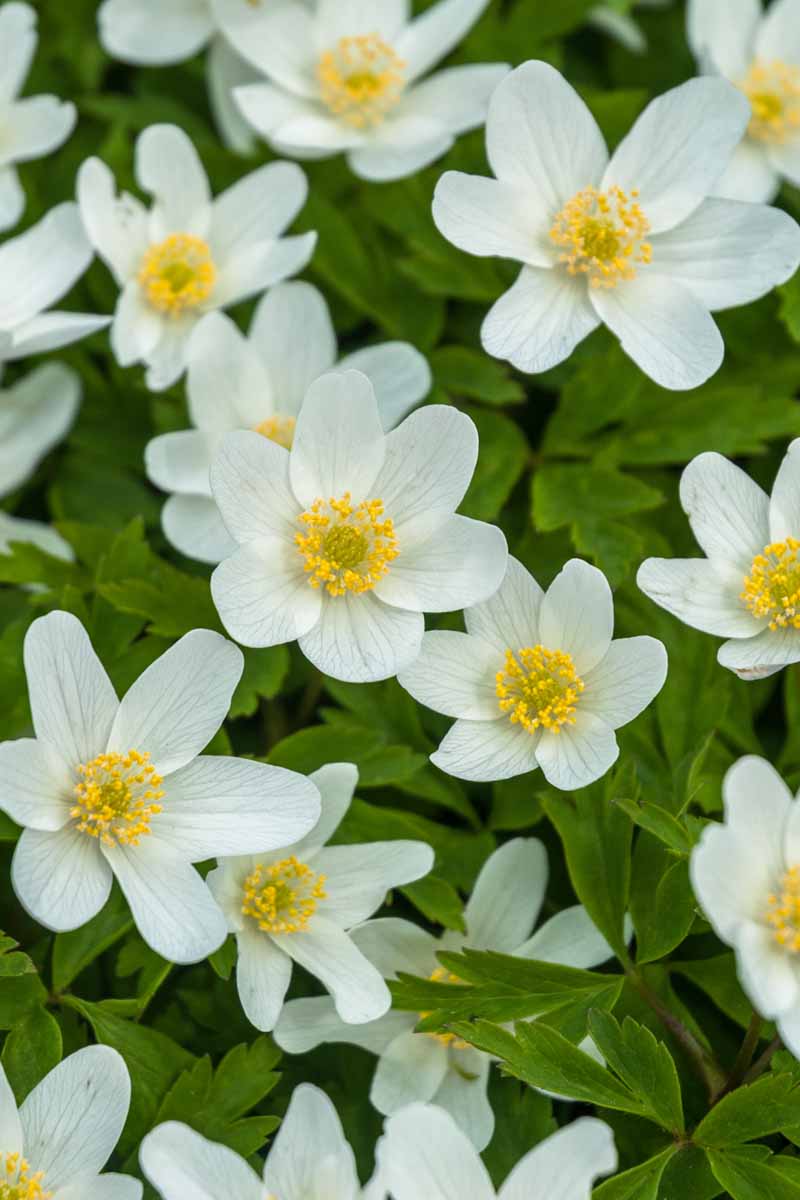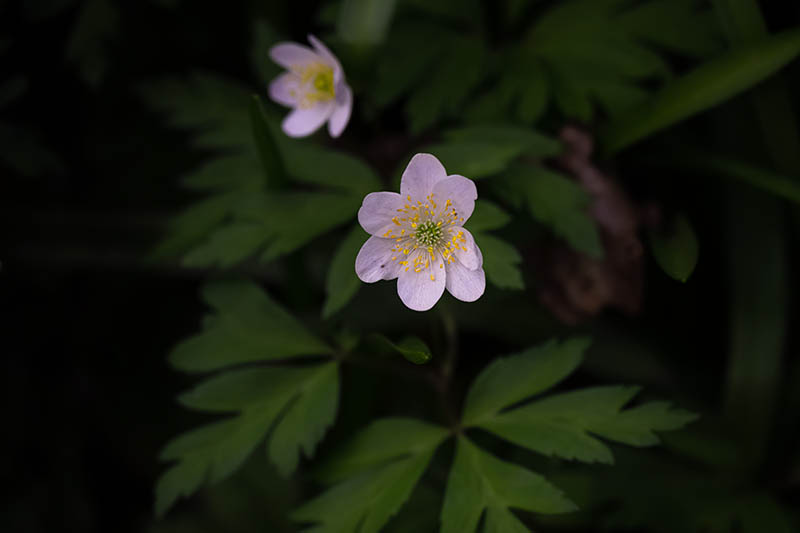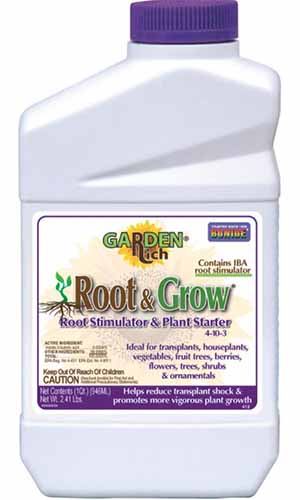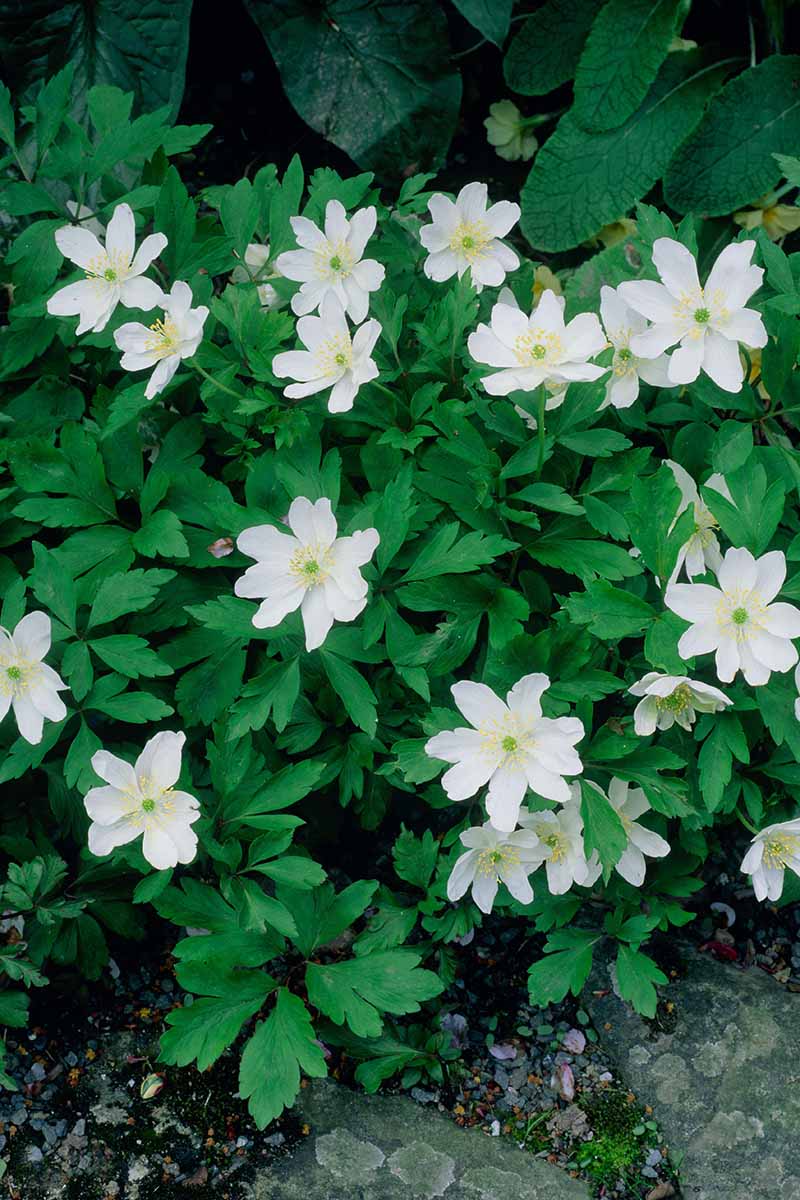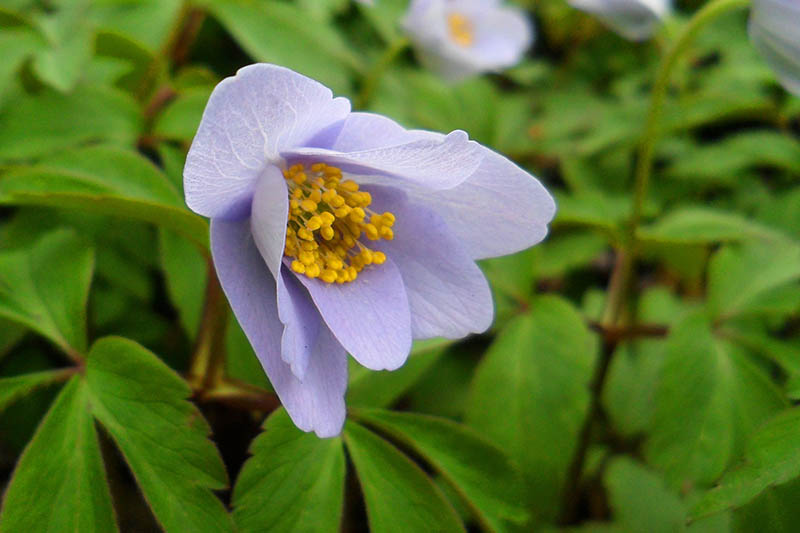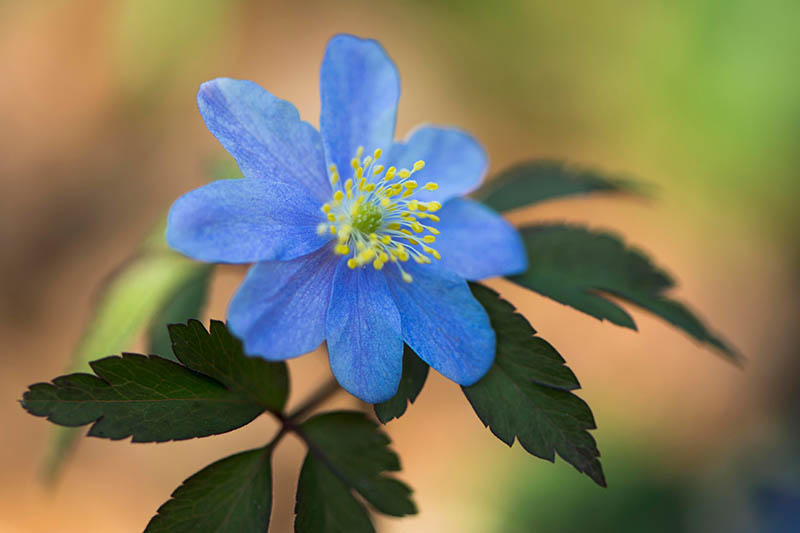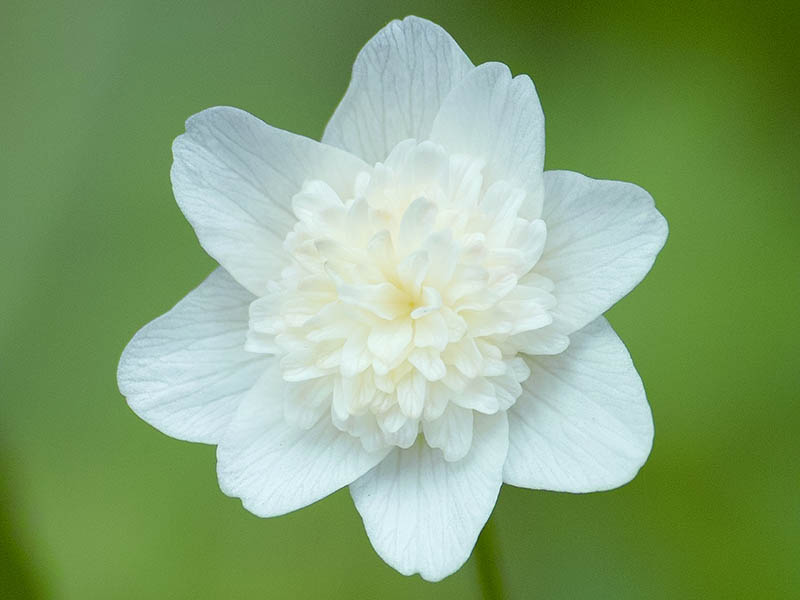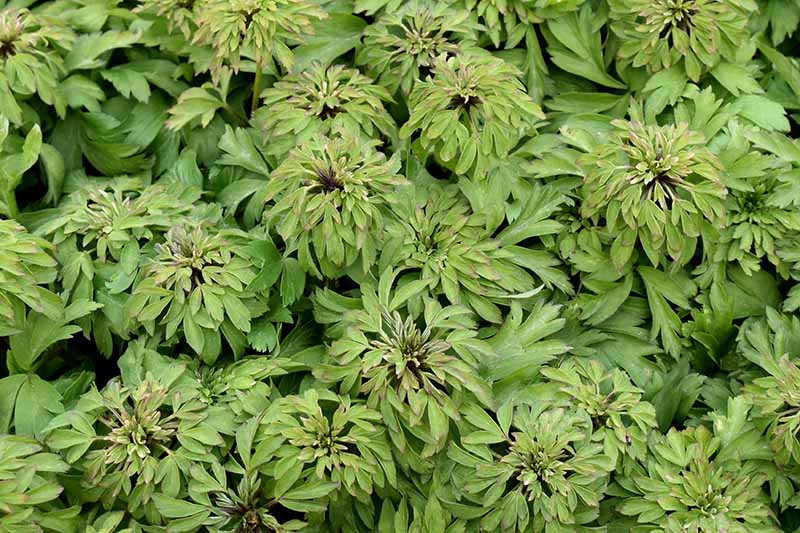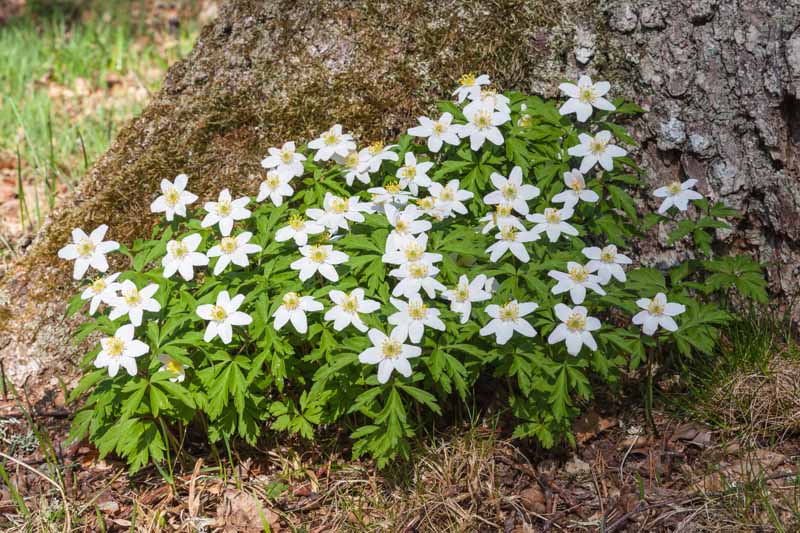If wood anemones are not found in a forest near you – or even if they are – you may want to bring their delicate grace to your home landscape, especially in the shadier areas of your garden. We link to vendors to help you find relevant products. If you buy from one of our links, we may earn a commission.
What Is Wood Anemone?
“If primroses are the harbingers of spring, then wood anemones are its confirmation,” writes gardening author Carol Klein. “The sight of shady banks and glades lit by their white stars on a sunny spring day leaves you in no doubt that spring is truly here.” That goes for both A. quinquefolia, the American wood anemone, as well as the closely related A. nemorosa, the European species – both of which are iconic symbols indicating that spring has truly sprung in their native regions. With 35 species and named hybrids in the Anemonoides genus as of August 2020 (and dozens more in the Anemone genus, which these species also previously belonged to – more on that a little later), only a few of these are commonly called wood anemone. Besides the two aforementioned species we’ll focus on here, Anemonoides ranunculoides is also sometimes called wood anemone, or yellow wood anemone more specifically. And A. oregana is known by the common names blue windflower, Oregon anemone, and Western wood anemone. Then there’s A. x lipsiensis, a hybrid cross of A. ranunculoides and A. nemerosa, which combines features from both plants with its light yellow flowers and an attractive bronze tint to its foliage. All are species of flowering plants in the buttercup or Ranunculaceae family, and many of these recently underwent a name change, as has been a common occurrence in botanical taxonomy in recent years. Many species once known as Anemone have since been reclassified as members of the Anemonoides or “anemone-like” genus, though you will often still see the old name in common usage at nurseries and online. You can treat these as synonyms and it’s safe to assume that no one will get hurt, except maybe the botanists responsible for reclassification. Both the European and American species are also called windflowers, a name inspired by the gentle rustling of their slender-stalked flowers in the wind. A. nemorosa is also known as smell fox and thimbleweed, while A. quinquefolia also goes by the name nightcaps. Both species are spring ephemerals, emerging in the early spring to soak up the sun before the overstory is in full leaf. The plants flower as early as March in the case of the former, or April in the case of the latter species, and continue blooming for up to three months. American wood anemone grows wild in eastern North America from Nova Scotia through to Minnesota and south down to Tennessee and Georgia. European wood anemone grows in temperate regions of central Europe and eastward to western Asia. Although they grow natively in different parts of the world, the plants look very similar. Both species grow to about one foot tall, give or take depending on the variety, and typically have white five-petaled flowers. However, there are varieties of A. nemorosa that have purple, blue, light green, or light pink flowers, and A. quinquefolia sometimes has light pink flowers as well, especially when the buds first open. The best way to tell them apart is that European wood anemones have three basal leaves, meaning they grow only at the base of the plant, while their American counterparts have three equally spaced leaves growing from nodes a bit further up the stem. Though the American species tends to produce fewer blooms per plant, the flowers of both species open with the light of day and follow the sun, closing again at night or under heavy cloud cover. American wood anemone grows as a perennial in USDA Hardiness Zones 3 to 8, while its European cousin thrives in Zones 4 to 8. Both prefer dappled shade and moist, rich soil that’s high in organic matter, and they do best with a good layer of leaf mulch applied, just like they would have in the forest. These flowers spread mostly via underground rhizomes. The European species can spread quickly in ideal growing conditions, while the American species typically spreads more slowly.
Wood anemones often form carpets of monocultural colonies, but they can also be seen in the wild interspersed with other woodland plants. They are especially at home when planted surrounding trees and shrubs.
Cultivation and History
Anemones have been part of human culture throughout much of our history, with the earliest recorded mention of the flowers appearing in Greek mythology. Besides having a connection to the Greek wind gods, the Anemoi, which serve as their namesake, a myth also exists involving the goddess Aphrodite and her mortal lover Adonis. The story goes that Adonis was gored by a wild boar when he was out hunting one day, and died in the arms of the weeping Aphrodite. As her tears mingled with his blood, wherever they fell, wood anemone flowers sprouted from the ground. This myth may be one reason that anemones were associated with love and fragility in Victorian times. Prior to this era, wood anemones were named and classified in 1753 by the Swedish botanist Carl Linnaeus, the “father of modern taxonomy,” who formalized our modern system of binomial nomenclature. Linnaeus also gave the European species the name Anemone nemorosa. Anemone quinquefolia wasn’t described until 1973 by Josef Ludwig Holub. Before this time, it was simply treated as a subspecies of A. nemorosa. As mentioned above, both were reclassified in 2020 as members of the Anemonoides genus.
Propagation
Wood anemone grows wild in many places, and though it is possible to transplant at certain times of year, it’s better not to disturb wild ecosystems. You can order plants, root cuttings (called “bulbs” by some stores), or seeds from nurseries and garden centers. You can also easily dig up root cuttings from mature patches in your own garden to spread them to other areas. Dormant rhizomes are most often available for shipment from nurseries in the fall. If you’re gardening in the US, you won’t find many places selling European anemone plants or root cuttings locally, but you may be able to find a company willing to ship them from Europe, and seeds of both species are available online. American anemones also tend to be a rare find in garden centers. If ordering plants from overseas, be sure to do your research to avoid violating any local regulations regarding importation of plants.
From Divisions/Root Cuttings
Dividing mature plants to encourage spreading can be done every three years or so, and it’s best to divide these plants in the late summer. At this time, they’ll be fully dormant, putting all of their energy toward the roots. You can easily dig a few inches down to bring up clumps of mature plants and tease them apart. If the roots are desiccated, soak them in water overnight, or for about eight hours. Then, plant them three inches deep spaced about six inches apart, mulch with leaves or straw, and water them in.
From Seed
Collect wood anemone seed in late spring or early summer when the small, spiky seed pods have almost completely (but not quite) dried up. Bonide Garden Rich Root & Grow To help transplants become established, you can also give them a shot of transplant fertilizer such as Garden Rich Root & Grow from Bonide, available from Home Depot. Follow the package directions for application. Check out this guide to learn more about dividing perennials. The sooner the seed is harvested and sown after ripening, the better, and these seeds are best sown as close to collection time as possible. Simply open the pods and remove the seeds. Alternatively, you can, of course, purchase seeds to sow, but note that seeds should be kept moist until sowing for best results. I recommend sowing them about one-quarter of an inch deep in seed starting trays that have been filled with a soilless seed starting mix. Four to six times more seeds than the number of plants you want to grow should be sown, since germination rates are often low. Once the seeds are planted, it’s time to cold stratify them outdoors. Dig the seed cells into a weed-free bed so they’re even with the soil surface, and mulch lightly with a sprinkling of shredded hardwood leaves to just cover the soil. Don’t use walnut or oak leaves, however, as these contain compounds that will inhibit germination. The seeds should then be kept moist. They will germinate when temperatures consistently reach 60°F during the day the following spring. Once your seedlings have two to three sets of true leaves, dig them up and repot them into four-inch pots, and grow them in light shade until early fall. Then, plant them out into their permanent positions, spaced six inches apart. Seed-grown plants will produce flowers in three to four years.
How to Grow
If you create the right conditions for them, wood anemones require little work to maintain and to produce beautiful blooms. One of the keys to success with any plant is to ensure you’re planting it into conditions that will help it to thrive. Wood anemones need nutrient- and humus rich-soil with a high organic matter content – the same type of soil found in their regular woodland habitat. Test pH and soil nutrients prior to planting, and amend the soil as needed. Although they can tolerate a wide range of pH levels, growing just fine in soils within a pH range of 6.0 to 7.5, they do best in soil that’s slightly acidic. To boost organic matter in preparation for planting, add two to three inches of compost, and mix it into the top four inches of soil. Their roots should be kept cool by spreading about three inches of mulch around the plants, with leaf mulch being the best option. Seed-free straw is also fine to use. Reapply mulch regularly to ensure that it is thick enough to protect your plants during the winter. Regularly adding a layer of mulch to keep it topped up to a thickness of about three inches is also important for maintaining soil moisture, and building organic matter. After compost has been added the first time, continually adding mulch will help to maintain organic matter levels so you won’t need to add compost again. Wood anemones require consistently moist (but not waterlogged) soil during their spring growing season, but they don’t mind drier conditions in the summer once they’ve gone dormant. These plants prefer partial shade, and they grow well in the dappled shade beneath deciduous trees. See our general guide to growing anemones for additional recommendations.
Growing Tips
Add compost prior to planting to build organic matter.Test soil to ensure balanced nutrient levels and amend as needed.Keep soil moist but not waterlogged.Keep plants mulched with three to four inches of organic material.
Pruning and Maintenance
Wood anemone flower stalks may be cut once flowering is done, to give them a tidier appearance. Be sure to wear gloves when you work with these plants, to avoid skin irritation. Otherwise, besides regularly adding mulch and ensuring that the soil remains moist, there is little else to do in terms of maintaining these perennials. To encourage spreading as a ground cover, or to bring anemones to new areas of the garden, divide mature plants every three years as described above.
Cultivars to Select
Although there are no named cultivars of the American wood anemone, many cultivated varieties of the European species have been developed. Here are a few of our favorites:
Leed’s Variety
Reaching a height of five to six inches, this variety is known for spreading quickly, and it works well as a ground cover. Also notable are its large, two-inch-wide single white flowers that may sometimes flush pink as they age. Suitable for growing in Zones 4 to 8, some growers also note the Verticillium wilt resistance of this particular cultivar.
Robinsoniana
A blue-flowered cultivar that reaches four to six inches in height at maturity, ‘Robinsoniana’ is best suited for growing in Zones 4 to 9. This variety grows and spreads more slowly than some of the others, with single blooms that are yellow in the center. Royal Blue Suitable for growing in Zones 5 to 8, this light-blue-to-lavender-flowered cultivar will make a lovely addition to the garden when planted with other blooming shade-lovers in contrasting colors. The flowers are a darker shade of purple on the back side, and plants reach a height of three to four inches, shorter in stature than other cultivars.
Vestal
A double white variety, this one has blooms noted for lasting longer in the garden than those with single blossoms. ‘Vestal’ does best in Zones 4 to 9, and plants reach a height of six to eight inches. It is also noted for spreading more slowly than some varieties.
Virescens
With single, pale green flowers that resemble leafy rosettes, this unique type grows best in Zones 4 to 8. Plants reach a height of about six inches, and it spreads nicely to form an attractive ground cover.
Wyatt’s Pink
We’d be remiss to leave you hanging without a pink variety to choose from! The rose-colored single blooms of ‘Wyatt’s Pink’ feature touches of white around the edges of the petals, adding pretty pastel shades to the early spring garden. This cultivar grows best in Zones 4 to 8, and plants reach a mature height of six to 12 inches.
Managing Pests and Disease
Anemones are typically without any serious pest or disease issues, but they can occasionally have problems, especially if they lack proper growing conditions. Snails and slugs may turn up, but little else can tolerate this poisonous plant. Read more about ridding the garden of these pests in our guide. Caterpillars may occasionally munch holes in the leaves. These can be treated with Bt when you see them. But as these plants are poisonous to most insect hosts, and both moths and butterflies serve as beneficial pollinators, it may be best to leave well enough alone. In the case of a severe infestation, caterpillars can be picked off of plants by hand, and moved elsewhere in the garden. Leaf and bud eelworms, or foliar nematodes, may also like to make a snack of your plants. These are common during periods of moist, cool weather. They are often spread via infected nursery stock, and plants should be inspected for signs of damage before planting in the garden. Once established, these nematodes can affect a wide range of host plants. Remove and dispose of infested plant parts, keep the garden clear of debris, and be sure to pull any weeds you see, as these may serve as hosts as well. One the disease side, you may encounter powdery mildew and rust, as well as the anemone cup mushroom. Though the rhizomes of wood anemones may serve as host to anemone cup mushrooms (Dumontinia tuberosa), they pose little threat to the health of plants, and are not known for causing any specific type of disease, though plant guides often make mention of this species. In fact, they have a quite unique, whimsical appearance! The brown fungi emerge from the ground attached to the rhizomes, and they resemble wood ears before taking on their more cuplike appearance. You can remove the fruiting bodies and dispose of them if you choose, but your plants shouldn’t suffer. Most types of rust are host-specific and overwinter on leaves, stems, and spent flower debris. Often appearing as small rust-colored pustules on the underside of leaves, these will leave a colored spores behind on your fingers if you touch them. A fungal disease spread by splashing water or rain, rust is worse when the weather is moist. Plant resistant varieties if you can find them, and provide maximum air circulation. Be sure to clean up all debris from the garden, especially around infected plants. Fungicide sprays labeled for rust may be used to treat plants. Powdery mildew is another fungal issue related to a lack of adequate air circulation, or adequate light. Infections are typically worse when nights are cool, and days are warm and humid. You’ll typically see the powdery white fungus on the upper surface of leaves, and in the case of a severe infection, foliage will curl, turn yellow or brown, and fall off the plants. Be sure to provide appropriate spacing between plants to prevent powdery mildew, and see our guide to home remedies for treatment suggestions. Do not water from overhead, and water only during the day so that plants will have enough time to dry before nightfall to prevent fungal disease issues like rust and mildew.
Best Uses
Suitable for planting on banks and slopes, and in beds or borders in shady areas, wood anemones can also be grown in containers – a boon to small space gardeners without a lot of sun exposure! A suitable addition to cottage gardens or those with an informal, natural style, these low-maintenance plants may be naturalized in lawns, rock gardens, or woodland areas, and are well-suited for underplanting with shade-loving trees and shrubs as standalone specimens or a spreading ground cover. With a variety of colors and sizes available, though wood anemones can be hard to find, the search for these cherished perennials proves its worth in the dappled shade of woodland gardens whenever they are in bloom. Are you growing wood anemones at home, or have you spotted them in the wild? What are your favorite varieties? Feel free to share your stories, photos, and questions in the comments section below – we love hearing from you! And for more information on growing gorgeous anemones in the garden, read these guides next:
How to Grow and Care for Candle Anemones15 of the Best Anemone Varieties for Spring, Summer, and FallHow to Grow Fall-Blooming Japanese Anemone Flowers
